Finished product of the 3D printed cowboy hat!
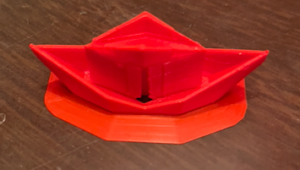
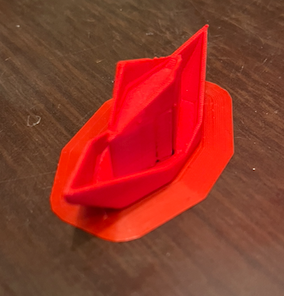


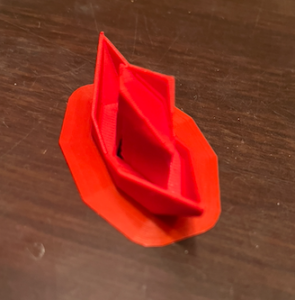
Comparison between oragami and 3D printed object.
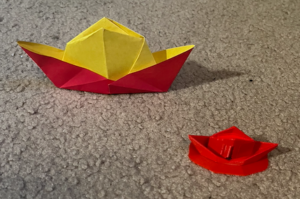

Never stop learning, because life never stops teaching
Finished product of the 3D printed cowboy hat!





Comparison between oragami and 3D printed object.


The autotelic activity and self determination theory are two things that really stuck out to me during the video game lecture. A couple thoughts that came to mind; why have I been playing for so long, and why do I want to improve at every game I play? I dove into the autotelic activity and realized the reward system is definitely something that motivates me. I have the personality of a perfectionist, so I will practice until I am excelling. Not just for myself, but to benefit the people I play with as well. Which is where the social aspect comes into play. I really enjoy connecting with friends online and having chemistry within different games. Furthermore, having success in video games both on my own and with friends can enable things within the body like endorphins, dopamine, serotonin, oxytocin, and adrenaline. All of these things play essential roles in regulating mood, emotions, and physiological responses in the body. The biggest thing I have realized in all of this research is the positive feelings coming from video games, the rewards I feel for having success and good times with friends has me craving more all the time.
I’m thrilled to share my journey into the world of podcasting. An experience filled with excitement, a few challenges, and lessons learnt along the way. Co-creating my first-ever podcast has been a unique experience. It all started with a discussion with my fellow group members as we had to select a topic from a list provided to us. There seemed to be a passion for the topic of artificial intelligence, and the desire to discuss how it can be used in different parts of life. Armed with a microphone on my computer, some research, and some enthusiasm, I embarked on the journey of bringing my thoughts to life.
Deciding the podcast’s theme was a crucial step. What did I want my short section to sound like? Who was my target audience? These questions fueled my content creation process. From scripting an engaging intro to planning my core content, every step was a step closer to the final product.
As a beginner, navigating the technical aspects of podcasting was a new journey all on its own. Learning how to use recording software and editing tools—I had to acquaint myself with a whole new language. It took me a few tries, but after I worked out some kinks, I knew I was going to have success.
Connecting with an audience was a thought I had during the entire process. AI is continually growing as a tool that lots of people are using and I feel that we are putting together a podcast that is insightful and unique. In my portion I wanted to state what AI is and a little history behind it, although we only have about a minute each, I thought I did a fairly nice job of getting my points across in the allocated time.

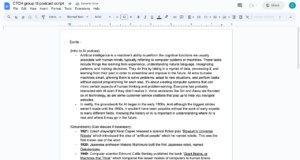

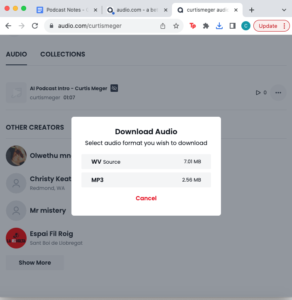
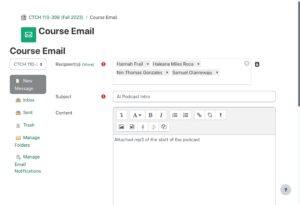
Podcast Script
Hello everyone, on today’s podcast we are going to be discussing artificial intelligence, and how it has grown to be a huge part of our daily lives.
(Intro to AI podcast)
References
McKinsey & Company. (2023, April 24). What is ai?. McKinsey & Company. https://www.mckinsey.com/featured-insights/mckinsey-explainers/what-is-ai
Rockwell, A. (2017, August 28). The history of Artificial Intelligence. Science in the News. https://sitn.hms.harvard.edu/flash/2017/history-artificial-intelligence/
Reflection
Fixing the Code
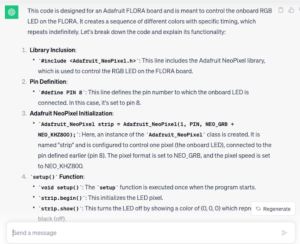


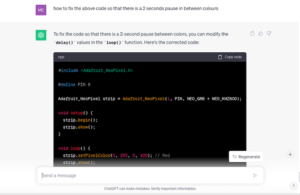

Final Code
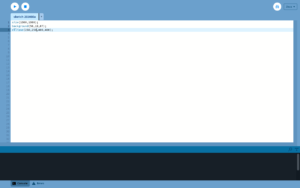

Once I got following along with the lab I started to get rolling and this was the first image I was able to create.
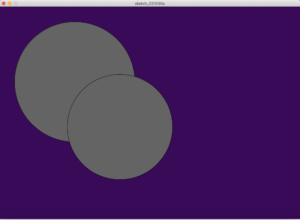
From there I got into the changing of colors and adding more shapes.

Tried out a different shape and new colors.

The next task was getting a shape to move across the screen, after a few attempts we got it.

The final results of the creative coding.
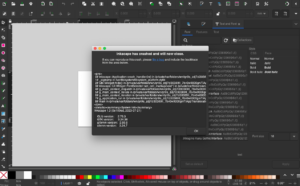
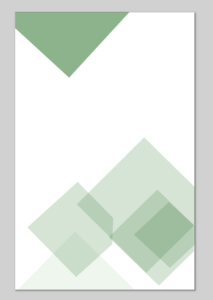
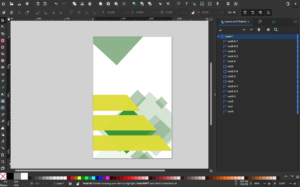



From figure 3 I wanted to carry over the concept of having the title as the first thing that attracts the eye. I think this design does a great job of that and it has overall balance. The same can be said about figure 1, the title is at the top of the page design and has added color to attract the eye. Working from top to bottom the text flows well and is easy to process. I took the color combo from figure 2 and made my own colors flow more freely. I tried to use the opacity tool to allow the blocks to sit over each other and blend together.
Contrast with the colors of the jersey I am wearing for the blocks is something I wanted to focus on, which helped make up the overall layout of the design. I repeatedly used different sizes of blocks to create an appealing design, I thought it gave the design balance and a small amount of visual hierarchy. Starting with the large words at the top, followed by a picture, then moving into the buzzwords in the yellow spaces.
Overall the experience with inkscape was extremely beneficial, although it did crash a few times I was fortunate enough not to lose too much valuable material. I learnt my lessons quickly and saved as I went. I was able to use many different youtube tutorials to end up with my finished product. One of the most crucial tools was the one to select multiple objects and blend to create new objects, this allowed me to take my design to the next level. The bitmap tracing got a little tricky, but after lots of trial and error I finally got the background of my image blended in with the white background. This was a large headache for me and it was a huge relief when I finally solved the puzzle.
Works Cited
Images, A. (Photographer). (February, 2022). University of Regina Goalie [Online Image]. Retrieved October 3rd, 2023. Retrieved February 4, 2022 from https://arthurimages.photoshelter.com/index
 Azizullah Lal
Azizullah Lal
Published: February 16th 2022
This podcast cover appealed to me because of the large image and the bolded title at the top. The red behind opinion makes the cover more appealing to the eye. The movement of my eyes went from the title to the short description of the podcast. The words are slightly difficult to read but zooming in makes it better. Next my eyes travel to the time which also pops on the page, followed by the creator of the cover. The overall topography flows nicely and I want to include that in my project
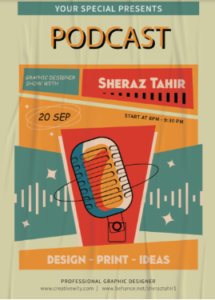
Muhammad Sheraz Tahir
Published: September 17th 2023
I liked this design because of the color concept and the low contrast of the design. There is a pattern to the design but it is mostly asymmetrical in the way it is laid out. The unity also gives the design a pop and is eye-catching. The use of layering colors really appeals to me.

Zafeer Gul – Published: March 9th 2023
This cover art caught my eye because of the scale that the words have compared to the pictures. The movement of my eyes went from “Night Podcast” to “Just Sit Back & Chill”. The words emphasize to the listeners to take some time from their night and sit back and enjoy learning about how to become a successful entrepreneur. The white text pops on the black background and the blue in the back gives the art a nice overall look.
Works Cited
Figure 1. Lal, A. (Creative Designer). (February, 2022). Podcast Cover [Online Image]. Retrieved October 3rd, 2023 from https://www.behance.net/gallery/137566463/podcast-cover?tracking_source=search_projects|podcasts+podcast+cover+art
Figure 2. Sheraz Tahir, M. (Graphic Designer). (September, 2023). Podcast Poster Design [Online Image]. Retrieved October 3rd, 2023 from https://www.behance.net/gallery/180208459/PODCAST-POSTER-DESIGN?tracking_source=search_projects|podcasts
Figure 3. Gul, Z. (Graphic Designer). (March, 2023). Podcast Cover Art [Online Image]. Retrieved October 3rd, 2023 from https://www.behance.net/gallery/165575859/Podcast-Cover-Art?tracking_source=search_projects|podcasts+podcast+cover+art
Pretty cool experience to dive into tinkercad and learn the ins and outs on how to use it. At first I was getting frustrated as I was obviously not very good even after I watched tutorial videos. Just like anything else, with practice I got much better and was able to create my cowboy hat with lots of detail. I am extremely happy with how it turned out!
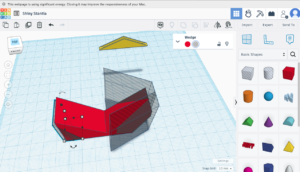
^ Learning how to edit to create new designs

^ Duplicated design to try some different things out and compare the two

^ Looking pretty close, having fun with the process
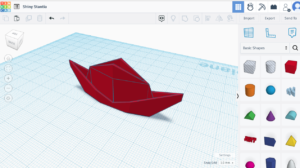
^ Changed the colouring to solid red, easier to print even if it does not match original origami

^ Lastly had to get the measuring tape out to make sure my design is legal to print, hope my math is correct!
First crack at origami went pretty well, found a cool design for a cowboy hat. Not the most even fold in the world but overall I am very happy with how it came out.


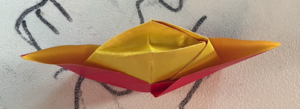
 – Lots of drinking water throughout the week
– Lots of drinking water throughout the week
 – Front side of postcard
– Front side of postcard
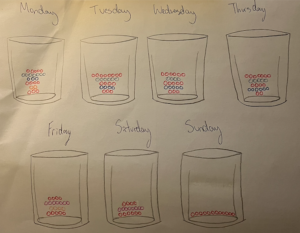 – Back side of postcard
– Back side of postcard
Dear Data Reflection:
Keeping a detailed record of how many times I drank water every day for a week as part of the “Dear Data” assignment was an eye-opening experience. At first, I didn’t think much about this seemingly simple task, but I was excited nonetheless to see what habits I have built during the beginning of the school year. As the days went by, I began to notice patterns and gain insights into my daily routines.
One of the most significant takeaways was realizing how consistent my water intake was. Most of my days are fairly similar during the week. I noticed that I drink small amounts of water in the morning and lots in the evening. My afternoons are filled with class, workouts, and practices and during these times I had consistent numbers tracked. It made me think about the importance of being hydrated before these activities, rather than compensating after the fact.
Ultimately, the “Dear Data” assignment highlighted the power of data visualization and tracking in understanding personal behaviors. The visual representation of my water consumption over the week allowed me to see trends and fluctuations that might have gone unnoticed otherwise. Being a student athlete, many people including trainers and coaches are always preaching to take care of your body. I personally believe water consumption plays a huge role in maintaining a healthy body and lifestyle. After this assignment, I will continue to track my water and ensure I am intaking enough before my activities to avoid being dehydrated and recouping after the fact.
© 2025 Curtis Meger
Theme by Anders Noren — Up ↑
Recent Comments